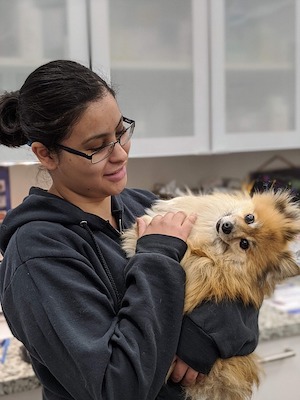Does Your Pet Need an Annual Exam?
Posted: 11/06/2023 | BY: Erin Cain | Categories: Uncategorized
Your dog or cat is a happy, lively, seemingly healthy pet, thriving in their environment and with their family. Does your pet need an annual exam, even if he shows no signs of discomfort or illness? Just like humans, pets should have a yearly physical; it’s one of the most proactive things a loving pet parent can do for their furry companion. Veterinarians everywhere urge pet parents to schedule an annual exam for their pets. Here’s why you should make an appointment for your pet’s annual exam today.

What is an annual pet exam?
An annual pet exam for a dog or cat, sometimes called wellness care, is a yearly physical for your pet; by the time your pet becomes a senior, most veterinarians suggest a physical exam every six months. The purpose of the exam is to make sure your pet is and remains healthy.
Sometimes pet parents think their pets are doing well when they aren’t. Many pets, particularly cats, follow their evolutionary process of survival. Their ancestors learned to hide pain to protect themselves from predators, and that trait has carried over to our domesticated pets today. An annual exam can help root out problems that you didn’t know existed.
Research indicates there are more pet parents than ever; however, preventative care trips to the veterinarian have decreased while instances of preventative illness have increased. You want to make sure your pet is healthy so he can live a long, fulfilling life. An annual exam will ensure that your dog stays well and that any diseases or illnesses are identified and treated early.
What can you expect during an annual wellness visit?
The average price of an annual physical exam is between $45 – $55, with additional costs charged for vaccinations, heartworm tests, and preventive medication. Some veterinarians offer complete wellness packages that include discounted prices for shots, flea and tick preventatives, and heartworm tests.
Exams often include these checkpoints:
- The ears and eyes are checked through hearing and vison tests and examinations for irritations, swelling, itchiness, redness, or discharge.
- The teeth and mouth are checked for early signs of periodontal or gum disease and issues such as tartar growth and cracked or broken teeth.
- The heart and lungs are examined to listen for any abnormal rhythms or sounds.
- Testing for internal parasites such as heartworms and hookworms.
- Body condition scoring is assessed to determine whether a dog is underweight or overweight or at the condition expected of his age and breed.
- The coat and skin inspection occur because these areas often reflect or cover up underlying illnesses, i.e., excessive shedding, lumps, discoloration, dry skin, unusual spots, or rashes.
- Limbs are maneuvered to observe standing, walking, and toenails.
- Checks for ticks, fleas, and mites with added flea and tick prevention if desired
- The organs are checked to make sure they are not enlarged.
- The administration of vaccines for rabies, distemper, parvovirus, bordetella, amongst others.
- Blood tests, particularly for pets showing signs of illness or senior pets.
- Urine and fecal tests, typically for puppies; however, some veterinary wellness plans include testing in these areas as a yearly feature.
An annual exam tests all these areas of your pet as they age to assess their health and move quickly toward diagnosis and treatment if something abnormal is found.

How often should pets see the veterinarian?
How often should a dog or cat have a veterinary exam? For most dogs between the ages of 2 and 6, once a year may be enough. However, that situation may change depending on certain factors, including your pet’s age and breed.
Why age matters
For younger cats and dogs, a first veterinarian visit is crucial to establishing baseline laboratory values for their health and allowing them to become accustomed to veterinary exams and handling by strangers.
Because puppies and kittens grow rapidly, they often need to see the vet more frequently in their first year due to multiple necessary vaccinations. Also, blood tests can reveal early health problems so they can be treated quickly and ensure a long life for your pet. Pre-anesthetic blood work before a spay or neuter also assists in establishing your pet’s baseline health.
Older and senior pets — veterinary consensus is age 7 is geriatric — also need to see the veterinarian more than once a year. Updates on blood work and physical condition can help a veterinarian find, diagnose, and treat an emerging illness or disease. More in-depth testing aside from blood work includes dental care, weight checks, parasite control, and mental health (cognitive dysfunction syndrome). Your senior pet will live a longer, happier life with frequent checkups on his health.
Why breed matters
Sometimes your pet’s breed determines how often they should see a veterinarian. Brachycephalic dog breeds such as French Bulldogs, Pugs, and Boston Terriers, are at a higher risk of health conditions, such as obstructive airway syndrome, due to their physiology and genetics. Some cat breeds, such as the Manx, the Ragdoll, and the Siamese, may suffer similar heredity medical issues. If your breed of pet falls into these categories, chances are he will need to see the veterinarian more often than other types of pets.

How can pet insurance help cover annual exams?
Some pet parents may balk at the price of an annual pet exam, but pet insurance can help pay for wellness care. Some pet insurance companies offer wellness coverage, which can include any of the following procedures:
- Routine screenings
- Wellness exams
- Microchipping
- Parasite prevention
- Dental care
- Spaying or neutering
- Vaccinations
- Deworming
If your concern is the cost of annual exams, consider a pet insurance policy that will assist you in paying for your pet’s wellness care. Need a quote? Get a free pet insurance quote and sign up for a policy. With the help of pet insurance, you can make sure your pet, no matter his age or breed, receives all the care he needs for a pawsome life.
References:
- Pirtle, R. (2017). Annual Exams vs. Semi-Annual Exams. Retrieved from https://thepethospitals.com/annual-exams-vs-semi-annual-exams/
- Feldman, G. (2021). Masters of Disguise: 7 Signs Your Cat is in Pain. Retrieved from https://www.thedrakecenter.com/services/cats/blog/masters-disguise-7-signs-your-cat-pain
- Texas A&M University Veterinarian Medicine & Biomedical Sciences. (2017). When is Your Cat Hiding Illness or Injury? Retrieved from https://vetmed.tamu.edu/news/pet-talk/when-is-your-cat-hiding-illness-or-injury/
- Wellness. (2021). How Much Will a Vet Visit Cost? Retrieved from https://www.wellnesspetfood.com/our-community/wellness-blog/how-much-will-vet-visit-cost
- Hetler, E. (2020). Talking to pet owners about preventative care: A primer. Retrieved from https://www.veterinarypracticenews.com/talking-to-pet-owners-about-preventive-care-a-primer/
- Essentials Pet Care. (2020). Understanding Why Your Pet Needs Blood Testing and When. Retrieved from https://essentialspetcare.com/understanding-why-your-pet-needs-blood-testing-and-when/
- Rivertown Animal Hospital. (2010). 4 Common questions about blood work and your pet. Retrieved from https://rivertownanimalhospital.com/files/diagnostic-testing-handout.pdf
- American Veterinary Medical Association. (2021). Senior pet care FAQ. Retrieved from https://www.avma.org/resources/pet-owners/petcare/senior-pet-care-faq
- Animal Clinic of Woodruff. (2021). Caring for Older Pets with Senility. Retrieved from https://www.animalclinicofwoodruff.com/pet-blog/107/Caring+for+Older+Pets+with+Senility
- Humane Society Veterinary Medical Association. (2018). Brachycephalic Breeds Fact Sheet. Retrieved from https://www.hsvma.org/brachycephalic
- Animal Wellness Center. (2021). Cat Breed Disorders. Retrieved from https://www.awcwi.com/cat-breed-disorders/
- Jones, S. (2021). Pet Wellness Plans: Manage Your Preventative Vet Bills. https://www.caninejournal.com/pet-wellness-plans/
Disclaimer
The information contained on this blog is intended for informational and educational purposes only and should not be construed as medical advice. It is not a substitute for professional veterinary care. Always consult with your veterinarian before making any changes to your pet's health care or treatment plan.
The authors of this blog are not veterinarians and do not claim to be experts in pet health. The information provided here is based on our own experiences and research, as well as information from reputable sources. However, we cannot guarantee the accuracy or completeness of this information.
We encourage you to do your own research and consult with your veterinarian before making any decisions about your pet's health.
Compare top pet insurance providers & plans.
Enter your dog’s age in years and months to calculate their age equivalent to human years.
Calculate your dog’s ageEnter your cat’s age in years and months to calculate their age equivalent to human years.
Calculate your cat’s age